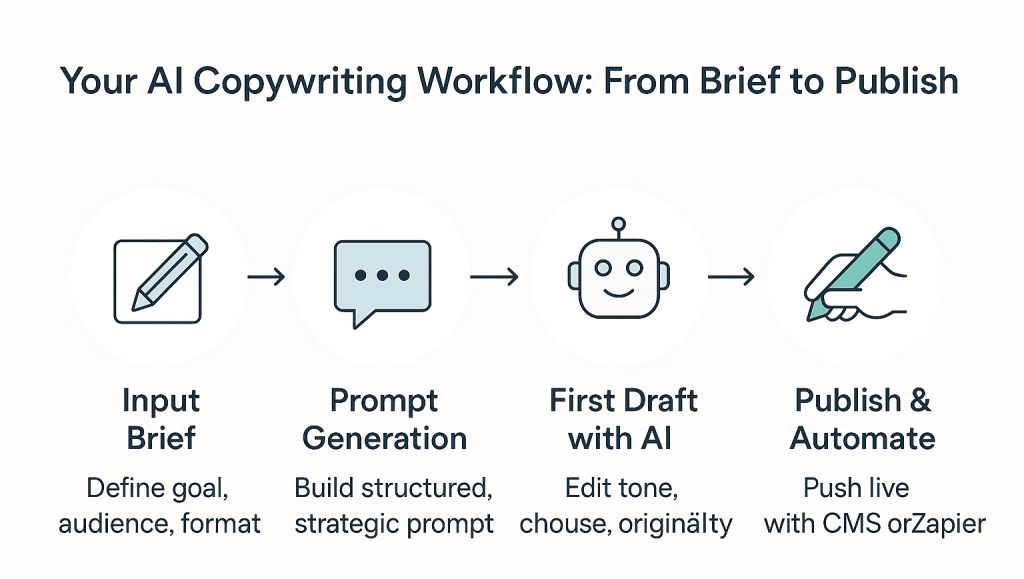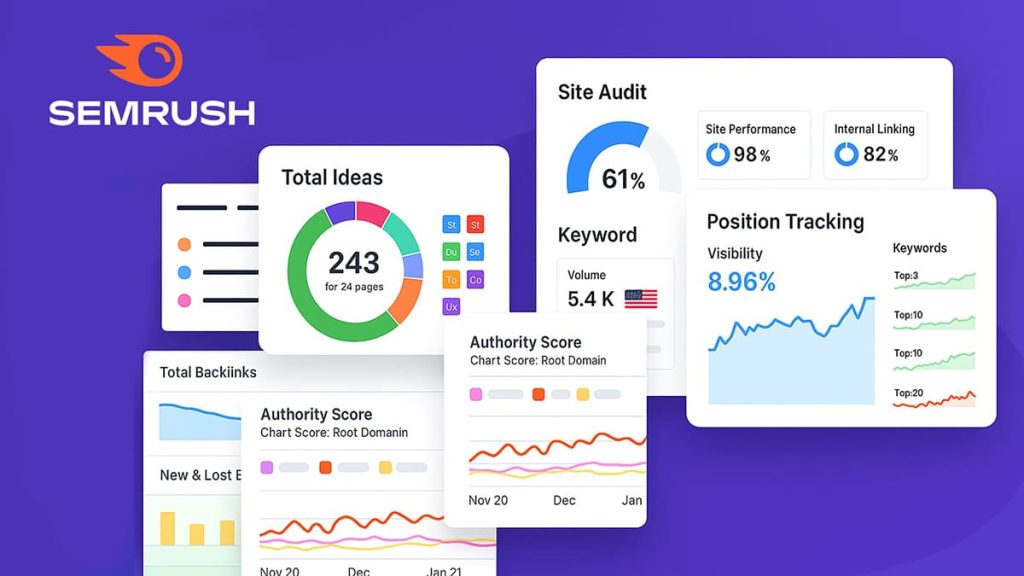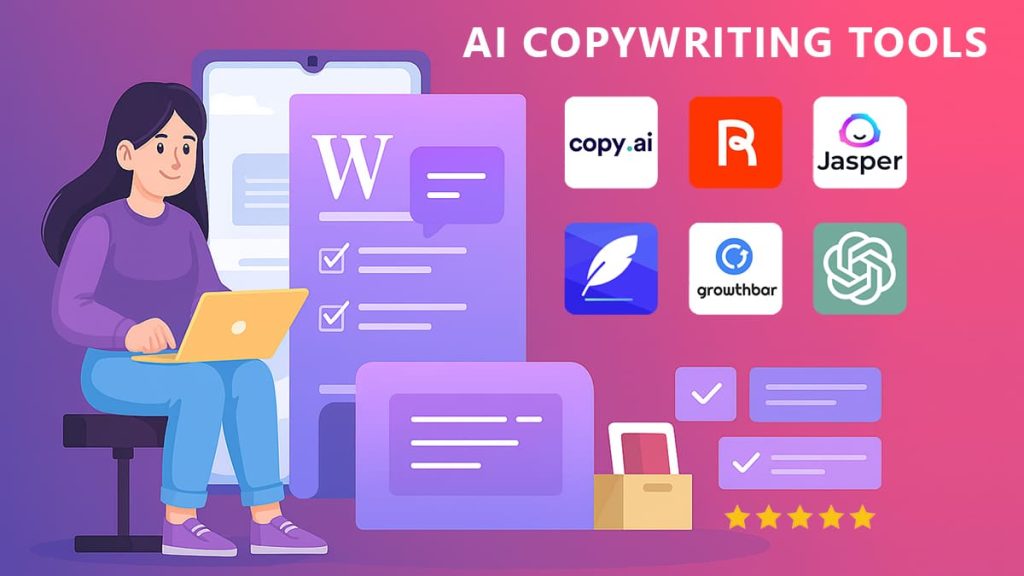Writing good copy meant long hours hunched over a blank doc, waiting for inspiration to strike. You’d sketch ideas on paper, obsess over word choice, and maybe burn through three cups of coffee before your first paragraph felt right. I’ve been there (too often). But now? It’s different.
AI copywriting tools have changed the way we create. Not just by speeding things up though, let’s be honest, that’s a massive plus but by unlocking new ways to brainstorm, draft, and even refine ideas we wouldn’t have thought of on our own. It’s like having a creative partner who never gets tired or runs out of ideas.
In this guide, I’ll walk you through what AI copywriting really is, the tools worth knowing, and how to use them to write faster, sound sharper, and keep your voice intact. Whether you’re building an email funnel, writing blog posts at scale, or just trying to get through your Monday to-do list, there’s something here for you.
As Ann Handley once said, “Good writing is good business.” AI doesn’t replace that truth it helps us live up to it, more consistently and with less friction.
What is AI copywriting?
Let’s get one thing out of the way: AI copywriting doesn’t mean robots are replacing writers. Not even close. What it really means is that artificial intelligence through algorithms trained on mountains of text can now assist in generating written content across a variety of formats. Think of it more like a writing assistant than a full-time ghostwriter.
At its core, AI copywriting refers to the use of machine learning models, particularly those based on natural language processing (NLP), to create, refine, or suggest copy. These tools have been trained on massive data sets: websites, articles, emails, ads you name it. When you input a prompt, the AI analyzes your request, pulls patterns from what it’s learned, and spits out something that often sounds like a polished draft. It’s not magic. But sometimes, it feels pretty close.
What makes this especially powerful is how AI tools structure content. Many can now suggest headlines, write introductions, outline blog posts, and even recommend tone adjustments to fit a brand voice. That’s not just convenient it’s a game-changer for teams juggling multiple campaigns and tight deadlines.
I remember the first time I tried an AI writing tool to map out a product landing page. Within minutes, I had three headline options, a CTA, and a fully structured outline. Sure, it needed polishing. But it gave me a solid runway and that’s the point.
Most AI copywriting tools today support a wide range of formats, including:
- Blog posts and long-form articles
- Social media content (captions, hashtags, posts)
- Email sequences (welcome emails, promotions, follow-ups)
- Ad copy (Google, Facebook, LinkedIn)
- Landing pages and sales funnels
- Product descriptions for ecommerce
- Video scripts or podcast summaries
In short, AI copywriting tools are versatile, responsive, and when used with intention can make the writing process feel a little less like staring at a blank page.
5 Game-changing benefits of AI copywriting
When I first started using AI to support my writing process, I expected minor time savings maybe a few auto-completed headlines or quick rewrites. What I didn’t expect was how deeply it would change my entire workflow. These aren’t just conveniences; they’re strategic advantages.

1. Faster content production
Let’s start with the obvious. AI copywriting tools can generate first drafts, outlines, and even metadata in a matter of seconds. No more staring at the blinking cursor for 20 minutes. For anyone managing multiple deadlines, this alone is a relief.
2. Improved ideation and creativity
You know those days when your brain just won’t cooperate? That’s where AI can help spark fresh angles. I’ve often fed it a half-baked prompt and received 4–5 directions I hadn’t considered. It doesn’t replace creativity it jumpstarts it.
3. More consistent tone and voice
For brands juggling several writers or channels, maintaining a consistent tone is tough. AI tools (especially ones with style training) can replicate your voice across product descriptions, emails, or blog intros without losing cohesion.
4. Increased output without scaling teams
Here’s where the real leverage kicks in. Whether you’re a solo marketer or leading a small team, AI helps you punch above your weight. You don’t need to hire five extra writers to triple your production. You just need smart systems.
5. ROI through time saved and performance lift
Time is money but performance is gold. AI doesn’t just save hours; it often leads to higher-performing content through optimization prompts, A/B testing ideas, and better targeting.
And when you break it down, the payoff looks something like this:
| Use case | Traditional time | AI-assisted time |
|---|---|---|
| Blog post (1000 words) | 5–7 hours | 2–3 hours |
| Ad copy variations (5) | 1–2 hours | 15–30 minutes |
| Email sequence (3 parts) | 3–4 hours | 1–1.5 hours |
Used wisely, AI can turn time into traction. And once you’ve felt that momentum, it’s hard to go back.
Compare the top 6 AI copywriting tools in 2025
Trying to pick the right AI copywriting tool sometimes feels like browsing a menu with too many good options you know what you want (great content, fast), but each tool offers its own flavor. I’ve tested most of them over the past year, and while none are perfect, some clearly shine in specific use cases.
Let’s start with Jasper. This one’s a powerhouse if you’re in a fast-paced agency or need multiple voices. It offers over 50 templates and brand tone training. What stands out most is Jasper Chat it feels more like a teammate than a tool. That said, it’s not cheap, and it does have a bit of a learning curve.
Copy.ai is much simpler. It’s fast, intuitive, and great for quick tasks like social media captions or ads. I’ve used it when I needed ten variations of a tagline in a rush. But long-form content? Not its strong suit.
Writesonic falls somewhere in the middle. It’s one of the most affordable platforms powered by GPT-4, with 80+ templates and a neat SEO checker. Still, its tone can sometimes feel… off. Like it’s trying too hard.
ChatGPT is arguably the most flexible of the bunch. Thanks to custom instructions and plugins, it can write just about anything. But without careful prompts, it sometimes misses the emotional nuance or brand voice you need.
Wordtune isn’t a content generator per se it’s more of a rewriting wizard. I love using it to tighten messy drafts or rework headlines. But don’t expect it to create full posts from scratch.
Rytr surprised me. It’s affordable and surprisingly solid at maintaining tone once you feed it a writing sample. Still, its interface feels a bit dated, and some output needs more polishing than others.
Here’s how they stack up side by side:
| Tool | Best for | Starting price | Key features | Limitations |
|---|---|---|---|---|
| Jasper | Agencies, content teams | $49/mo | 50+ templates, brand voice, Jasper Chat | Pricey, learning curve |
| Copy.ai | Social media, ad copy | Free / $49/mo | 90+ tools, simple UI, fast output | Weak on long-form depth |
| Writesonic | SEO-friendly blog copy | $15/mo | 100+ templates, SEO checker, GPT-4 | Occasional tone inconsistencies |
| ChatGPT | Flexible multi-format writing | Free / $20/mo | Custom prompts, plugins, Code Interpreter | Needs careful prompting |
| Wordtune | Editing, rewriting | $24.99/mo | Rewrite tool, summarizer, tone control | Not a full copywriter |
| Rytr | Budget-friendly tone matching | $9/mo | Custom tones, multiple languages | Basic UI, light output |
Bottom line? The “best” tool depends on your needs but the worst choice is not trying any of them at all.
How to choose the right tool for your business
Here’s the truth most comparison charts won’t tell you: the “best” AI copywriting tool isn’t the one with the most features it’s the one that actually fits how you work.
When I was testing tools for my own workflow, I realized quickly that power meant nothing if the interface felt clunky or if the tone didn’t match my brand. It’s not just about what a tool can do it’s about how naturally it fits into your day-to-day.
So how do you know which one to pick?
Start by looking at ease of use. If the dashboard feels like a cockpit, that’s probably not ideal especially if you’re working with a team. A clean, intuitive layout matters more than bells and whistles.
Then there’s editing support. Tools that offer real-time grammar suggestions, tone adjustments, or rewrite options can be game-changers especially when you’re juggling multiple deadlines.
Customization is another dealbreaker. Can the tool adapt to your voice, or are you constantly rewriting to sound more human? Look for ones that allow brand voice training or prompt fine-tuning.
Integrations are key if you already use platforms like Notion, WordPress, Zapier, or Google Docs. The smoother the connection, the better your workflow.
And finally, consider collaboration features and support. If you work in a team, real-time editing, commenting, or even approval workflows are gold. And when something breaks, you want help fast.
Here’s a simple filter you can use before committing:
- Is the interface easy to navigate for both writers and non-writers?
- Does it support your brand tone or offer customization?
- Can it scale as your team or content needs grow?
- Does it integrate with your current tools and platforms?
- Is there responsive support or a learning hub available?
As one content strategist told me, “We chose the tool our interns could learn in under 30 minutes. If they can use it, anyone can.”
Prompts & frameworks that actually work
Here’s something I learned the hard way: even the best AI writing tool is only as good as the prompt you feed it. Type in “write a sales email” and you’ll likely get something dull, generic, or way off-brand. But tweak that prompt give it structure, emotion, a clear goal and suddenly, it sings.
That’s because AI doesn’t intuit context; you have to give it one. I like to build my prompts using this formula:
audience + format + goal + emotion/framework
So instead of just saying “Write a product description,” I’ll say:
“Write a short, benefit-driven product description (FAB style) for overwhelmed freelancers who need a faster invoicing tool.”
It’s a small shift, but it makes a huge difference.
Here are 10 prompts that consistently deliver strong results:
- Write a welcome email (PAS) for solopreneurs who just signed up for a free funnel course.
- Generate 5 AIDA-style headlines for a blog post on AI content audits.
- Create a CTA for a productivity tool focus on clarity, urgency, and curiosity (under 5 words).
- Write a short sales blurb (FAB) for a password manager app, targeting remote teams.
- Craft a landing page intro using StoryBrand for a personal brand coaching service.
- Write a testimonial request email for customers who used a copy template bundle.
- Generate social post variations (tone: witty and direct) for a video editing SaaS tool.
- Write a product page overview (FAB) for an AI blog writer aimed at agencies.
- Create a re-engagement email offering a free swipe file for inactive subscribers.
- Write a campaign tagline for a webinar on scaling with automation.
Understanding the frameworks makes all the difference:
- AIDA (Attention, Interest, Desire, Action) – Great for headlines, landing pages, and ads. Use it when you need to spark action fast.
- PAS (Problem, Agitate, Solution) – Perfect for emails or social copy that leans into pain points.
- FAB (Features, Advantages, Benefits) – Ideal for product pages and sales blurbs where clarity trumps fluff.
- StoryBrand – Use this when you need to position your brand as a guide and the customer as the hero (e.g., homepages or service intros).
When you combine clear structure with the right framework, you don’t just get better AI output you get persuasive, on-brand copy that actually converts.
From idea to publish: your AI copy workflow
If there’s one thing AI has transformed for me, it’s the copy production workflow. What used to feel like a messy sprint notes in Notion, drafts in Docs, edits in Slack is now a streamlined system with fewer bottlenecks and better output.

Let’s break it down. Whether you’re creating a blog post, a landing page, or an email sequence, your process can look like this:
- 1. Input brief: Start with a clear brief. Define the audience, intent, tone, and format. This could live in a Notion template, Trello card, or even a simple Google Doc. The tighter your brief, the better your output.
- 2. Prompt generation: Use the brief to craft targeted prompts. Remember that structure matters: audience + format + goal + emotion/framework. This is where the magic happens.
- 3. First draft: Feed your prompts into your preferred AI tool (Jasper, ChatGPT, Writesonic…). You’ll typically get a few decent takes choose one to build on. Don’t expect perfection expect momentum.
- 4. Human refinement: Edit for clarity, voice, and tone. Add examples, personal stories, and polish. This is the moment to infuse personality and make it sound… not like a robot.
- 5. Deployment: Once the copy is approved, push it live. Use CMS plugins, publishing tools, or automation via Zapier to speed things up. If you’re using WordPress, for example, you can drop the final draft right into a pre-formatted block with minimal effort.
The real power here isn’t just speed it’s consistency. When every idea goes through the same system, quality stops being random and starts being repeatable. And that’s how you scale great content without losing your voice.
AI copywriting mistakes to avoid
For all the excitement around AI copywriting, I’ve seen teams fall into traps that waste time and dilute their message. I’ve made a few of these mistakes myself usually when trying to move too fast or skipping the human part of the process.
The first mistake? Using generic prompts. “Write a blog post about marketing” will get you content, sure but not content that matters. You’ll end up with vague introductions, shallow advice, and nothing worth reading.
Then there’s the infamous robot voice. AI has come a long way, but if you don’t guide it with tone or context, the result sounds like a customer service chatbot wrote your sales page. It’s technically correct and completely forgettable.
Skipping human editing is another common trap. AI can get you 70% of the way there, but that last 30% the polish, the perspective, the story is where the real impact lives.
Don’t overlook tool quality, either. Not all AI platforms are created equal. Some can’t handle nuance or personalization, and others have limited formatting or weak tone control.
And finally, there’s the risk of unintentional plagiarism. AI models are trained on existing content, so when you copy-paste without refining, you might be publishing something dangerously close to someone else’s voice.
Here’s a checklist to keep your copy sharp and human:
- Don’t use the same prompt for every format or audience
- Don’t skip human editing or fact-checking
- Don’t ignore tone or brand voice settings
- Don’t rely on AI to sound original refine the message
- Don’t forget to scan for plagiarism before publishing
AI won’t write your life story, but it might just help you tell it better. We’ve looked at the tools, the workflows, the wins, and the mistakes. And if there’s one thing I’ve learned, it’s this: AI is a powerful writing companion, but it needs your brain and your heart to work well.
The future of copy isn’t cold or robotic. It’s faster, sure. Smarter, absolutely. But it’s still about connection, clarity, and showing up with something that sounds like you. And with the right approach, AI can help you do all of that at scale.
If this sparked an idea, raised a question, or even made you rethink how you write, I’d love to hear it. Drop your thoughts in the comments let’s keep the conversation going.









lool man this felt like you were in my brain lol… i’ve been juggling freelance gigs and always felt stuck when starting copy from scratch.
i tried Jasper once but gave up too fast. might give it another go now. btw, your “audience + format + goal + emotion” prompt trick? that’s geniu
ah man I’ve been there too… Jasper felt kinda too much for me at first ngl but once I started using better prompts it clicked way more…glad the formula helped !
btw what kinda freelance gigs are you working on?